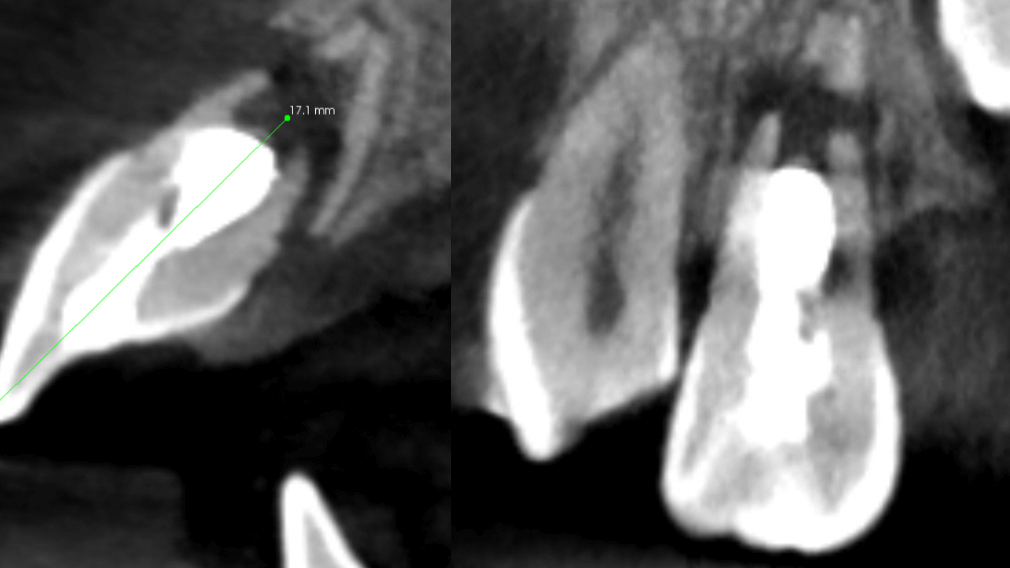Regenerative Endodontics: What are the options for failed cases?
Nestor Cohenca, D.D.S., FIADT
11/25/2024
Regeneration of necrotic pulps has become an alternative conservative treatment option for young permanent teeth with immature roots and is a subject of great interest in the field of endodontics. This novel procedure exploits the full potential of the pulp for dentin deposition and produces a stronger mature root that is better able to withstand the forces than can produce fracture.
Pulp revascularization of immature teeth with apical periodontitis depends mainly on: (a) disinfection of the canal; (b) placement of a matrix in the canal for tissue in-growth; and (c) a bacterial tight seal of the access opening. Since the infection of the root canal system is considered to be polymicrobial, a combination of drugs would be needed to treat the diverse flora. Thus, the recommended protocol combines the use of metronidazole, ciprofloxacin, and minocycline. Hoshino et al performed an in vitro study testing the antibacterial efficacy of these drugs alone and in combination against the bacteria of infected dentin, infected pulps, and periapical lesions (1). Alone, none of the drugs resulted in complete elimination of bacteria. However, in combination, these drugs were able to consistently sterilize all samples. In addition, a study by Sato et al. (2) found that this drug combination was very effective in killing bacteria in the deep layers of root canal dentin.
Unfortunately, intracanal bacteria could sturdily resist chemo-mechanical preparation and survive into remote and inaccessible areas of the root canal system, such as the apical part of root canals, isthmi, lateral canals, or dentinal tubules (3). Almutairi et al analyzed 28 studies that reported 67 failed cases of Regenerative Endodontic Therapy (RET) (4). A total of 37 failed RET cases reported the etiology that resulted in the initiation of RET; 59% of these cases were caused by dental trauma, and 30% were caused by dens evaginatus. A total of 26 (39%) failed RET cases were detected at least 2 years after the initiation of RET. A total of 53 (79%) failed RET cases were presented with signs and/or symptoms of persistent infection. Persistent infection was the main presentation in 79% of failed RET cases. Furthermore, 39% of failed RET cases were identi?ed after more than 2 years of follow-up.
References
1. Hoshino E, Kurihara-Ando N, Sato I, Uematsu H, Sato M, Kota K, et al. In-vitro antibacterial susceptibility of bacteria taken from infected root dentine to a mixture of ciprofloxacin, metronidazole and minocycline. Int Endod J 1996;29(2):125-30.
2. Sato I, Ando-Kurihara N, Kota K, Iwaku M, Hoshino E. Sterilization of infected root-canal dentine by topical application of a mixture of ciprofloxacin, metronidazole and minocycline in situ. Int Endod J 1996;29(2):118-24.
3. Chaniotis A. Treatment Options for Failing Regenerative Endodontic Procedures: Report of 3 Cases. J Endod 2017 Sep;43(9):1472-1478
4. Almutairi W, Yassen GH, Aminoshariae A, Williams KA, Mickel A. Regenerative Endodontics: A Systematic Analysis of the Failed Cases. J Endod. 2019 May;45(5):567-577
&srotate=0)
9-year old boy presents with a chronic apical abscess, after a failing attempt for pulp regeneration.
&srotate=0)
CBCT showing apical bone destruction and fracture of cortical plates.
&srotate=0)
2-year follow-up after apexification with MTA as an apical plug.
Recent Posts
ToothSOS for emergency care of traumatic dental injuries
ToothSOS for emergency care of traumatic dental injuries
Regenerative Endodontics: What are the options for failed cases?
Regenerative Endodontics: What are the options for failed cases?
Maxillary mucositis and its correlation to endodontically treated teeth.
Prevalence of maxillary mucositis and its correlation to endodontically treated teeth